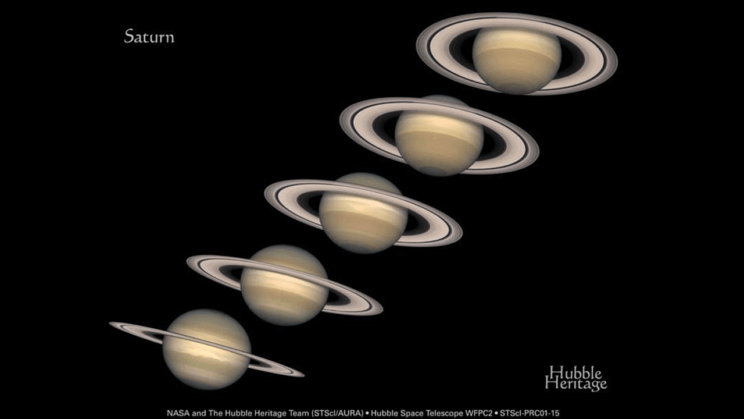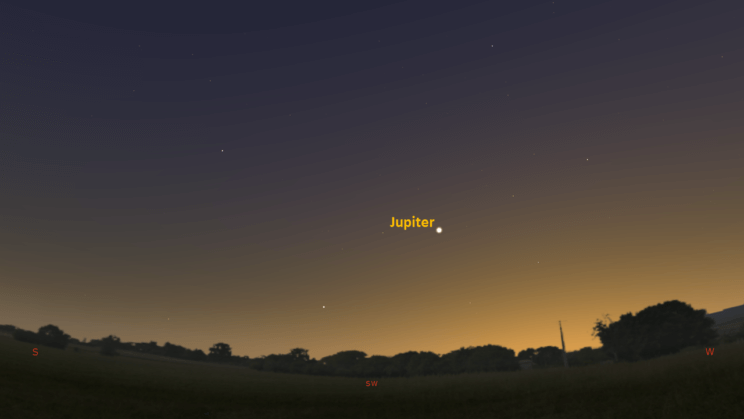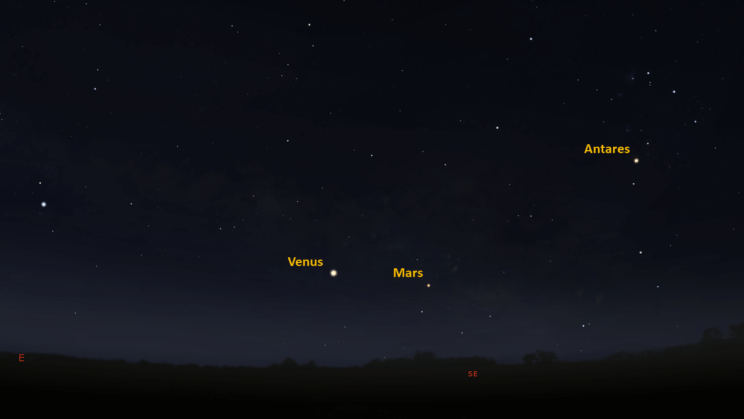This is the Saint Louis Science Center’s NIGHT SKY UPDATE for the week of Friday, January 21, 2022.
Information updated weekly or as needed.
Times given as local St. Louis time which is Central Standard Time (CST). For definitions of terminology used in the night sky update, click the highlighted text. If relying on times posted in Universal Time (UT), St. louis is -6 hours when CST.
Public Telescope Viewings
With the changing recommendations from the CDC regarding COVID-19, conversations regarding the return of star parties at the Saint Louis Science Center have begun. We are close to bringing back our public telescope viewings, but a few details still need to be worked out. We will post future updates as we learn more about when we can bring back telescope viewings.
Observing Highlight of the Week

The Saturn images above were taken by the Hubble Space Telescope from 1996 to 2001. The images show the transition of seasons on Saturn from an equinox to a solstice. Image credit : NASA and The Hubble Heritage Team (STScI/AURA).
This week Saturn reaches solar conjunction on February 4, 2022. This means we have lost another planet to the glare of the Sun continuing the trend of naked eye planets transitioning to visibility during morning hours. We were a bit spoiled over the last third of 2021 during which three and sometimes four of the naked eye planets were visible after sunset. Living up to their name, planets wander independently from the background stars which is why we are left with Jupiter being the lone naked eye planet visible after sunset.
Soon Saturn will join Mars and Venus in the morning sky just before the Sun rises. Those with clear views of the east and southeast horizons might see Saturn around 6:00 a.m. as early as the beginning of March 2022. Most of us will have to wait until the end of March to easily find Saturn in the twilight sky.
Saturn will be at its best from June to October 2022 when Earth catches up to Saturn in our orbit and then passes it by. During this time, Saturn will appear brighter and larger through a telescope. Saturn will appear its brightest on August 4, 2022, when it reaches opposition.
Saturn reaches conjunction with a few planets this year. On March 29, Saturn and Venus will be in conjunction and later on April 4, Saturn and Mars will reach conjunction. Unfortunately, the true moment of conjunction occurs during the daytime for both. That said, as Saturn is approaching conjunction with these planets, the pairs will make a nice target before the Sun rises.
Lastly, we are another year closer to equinox on Saturn. Like Earth, Saturn’s rotational axis is tilted which means we can see Saturn cycle through its seasons. Saturn completes one cycle of seasons every 29.5 years. As it orbits the Sun, Saturn’s northern and southern hemispheres will slowly be inclined towards the Sun. When Saturn reaches an equinox, our view from Earth presents Saturn’s ring system edge on. For a short time, Saturn’s rings will appear as a thin line. Saturn reaches equinox on May 6, 2025, and the next ring plane crossing occurs in March 2025. It will be interesting to track these changes through the rest of the decade.
The Sun and Moon

The Moon as seen from the International Space Station, on July 31, 2011.
Credit: NASA
Sunrise is at 7:10 a.m. on Friday, January 28 and sunset is at 5:18 p.m. providing us with roughly 10 hours of daylight. Even after sunset, the light from the Sun will dimly illuminate our sky for roughly 1 hour and 40 minutes. This period is called twilight, which ends around 6:50 p.m. this week. For those with a sundial, local noon occurs around 12:13 a.m. this week.
| Day | Sunrise | Sunset |
|---|---|---|
| 2022-01-28 | 7:10 a.m. | 5:18 p.m. |
| 2022-01-29 | 7:09 a.m. | 5:19 p.m. |
| 2022-01-30 | 7:08 a.m. | 5:20 p.m. |
| 2022-01-31 | 7:07 a.m. | 5:22 p.m. |
| 2022-02-01 | 7:06 a.m. | 5:23 p.m. |
| 2022-02-02 | 7:05 a.m. | 5:24 p.m. |
| 2022-02-03 | 7:04 a.m. | 5:25 p.m. |
| 2022-02-04 | 7:04 a.m. | 5:26 p.m. |
| 2022-02-05 | 7:03 a.m. | 5:27 p.m. |
Moon
Moonrise for Friday, January 28 occurs at 3:53 a.m. and moonset will occur at 1:23 p.m. On Friday, January 28 the Moon will exhibit a waning crescent phase with 15% of the lunar disk illuminated. New moon occurs on January 31, 2022, at 11:46 p.m.
International Space Station (ISS) Observing

Visible passes of ISS from St. Louis for the week of January 28 occur during evening hours. The best passes this week occur on February 3 and 4. Use the table below for information about these and other visible passes this week.
Catch ISS from St. Louis starting Friday, January 28
| Date | Starts | Max. altitude | Ends | |||||||
|---|---|---|---|---|---|---|---|---|---|---|
| Time | Alt. | Az. | Time | Alt. | Az. | Time | Alt. | Az. | ||
| 30 Jan | -1.4 | 19:06:55 | 10 | NNW | 19:08:00 | 16 | N | 19:08:00 | 16 | N |
| 31 Jan | -1.8 | 18:19:06 | 10 | NNW | 18:21:14 | 16 | NNE | 18:22:06 | 14 | NE |
| 01 Feb | -2.6 | 19:07:03 | 10 | NW | 19:09:14 | 33 | NNW | 19:09:14 | 33 | NNW |
| 02 Feb | -2.7 | 18:19:04 | 10 | NNW | 18:22:02 | 29 | NNE | 18:23:34 | 20 | ENE |
| 02 Feb | -0.6 | 19:55:48 | 10 | WNW | 19:56:31 | 15 | WNW | 19:56:31 | 15 | WNW |
| 03 Feb | -3.3 | 19:07:26 | 10 | WNW | 19:10:43 | 57 | SW | 19:11:02 | 53 | SSW |
| 04 Feb | -3.9 | 18:19:14 | 10 | NW | 18:22:34 | 78 | NE | 18:25:46 | 11 | SE |
| 05 Feb | -1 | 19:08:31 | 10 | W | 19:10:52 | 18 | SW | 19:13:14 | 10 | S |
Magnitude (Mag): The Measure of brightness for a celestial object. The lower the value is, the brighter the object will be.
Altitude (Alt): The angle of a celestial object measured upwards from the observer’s horizon.
Azimuth (Az): The direction of a celestial object, measured clockwise from an observer’s location with north being 0°, east being 90°, south being 180° and west being 270°.
For information about ISS flyovers and other visible satellites, visit www.heavens-above.com
Detailed information regarding all unmanned exploration of our universe, missions past, present, and planned, can be found at Jet Propulsion Laboratories:
The Visible Planets

Looking southwest, at 6:00 p.m. January 29, 2022. Credit: Stellarium, EG

Looking southeast, at 6:00 am, January 30, 2022. Credit: Stellarium, EG
This week, three naked eye planets are visible. Jupiter is visible in the southwest after sunset. Venus and Mars are both seen in the east before sunrise.
Venus
Venus has started a morning apparition and as such will be seen in the southeast before sunrise. This morning apparition lasts until the third week of October 2022. Venus reaches superior conjunction on October 22, 2022. Look for Venus around 6:00 a.m. low in the southeast.
Mars
A new apparition for Mars has begun. Mars rises at 5:03 a.m. Start looking for Mars around 6:00 a.m. as it clears trees and buildings. Mars will continue to climb out of the Sun’s glare as it heads towards opposition later this year on December 7, 2022.
Jupiter
Look for Jupiter in the southwest as it starts to darken outside. Jupiter sets at 7:26 p.m. and will set about 20 minutes earlier each week. Jupiter reaches superior conjunction on March 5, 2022.
James S. McDonnell Planetarium
Night Sky Update: January 28 – February 5, 2022






